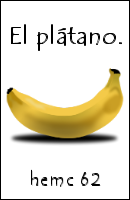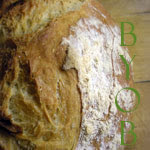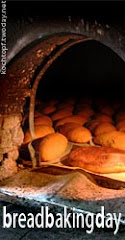
For English Translation, scroll down.
Cathy, de "Bread Experience" es la anfitriona del BBD #29 y nos propone "Pan en Olla". Me encanta hacer el pan en olla porque queda fenomenal. Como siempre, estuve buscando recetas, y saben qué, encontré una receta de Cathy y fue la que hice. Aquí os pongo el enlace, ya que ella tiene un paso a paso estupendo. Si quieren verlo, aunque está en inglés, pinchen aquí.
Ingredientes:
4 tazas harina de trigo (más, taza y media por si se necesita)
2 cucharadas de azúcar blanquilla
1-3/4 cucharadas de sal gorda
¾ cucharaditas de levadura de panadero
Aceite vegetal
1-3/4 tazas + 2 cucharadas de agua helada (más, una taza, por si se necesita)
1/3 taza de leche “buttermilk: (1/3 taza de leche entera + una cucharada de vinagre)
2 cucharadas de mantequilla sin sal derretida
¾ cucharadita de sal gorda (para adornar—opcional)
Preparación:
Primer Leudado
En un bol grande, mezclar 4 tazas de harina, el azúcar y la sal.
Añadir el agua, donde previamente se haya mezclado la levadura. Yo: utilicé la mezcla de leche con el vinagre, y le añadí la levadura de panadero. Si la mezcla se ve demasiado seca para incorporarle toda la harina poco a poco, añadir un poco de agua (fria) para mezclar los ingredientes: “No lo sature de agua”, ya que la masa deberá verse algo dura. Si se ve demasiado húmeda, ir añadiendo harina hasta que se vea más consistente. Mezcle en KA (o cualquier robot de cocina para amasar, durante 5-8 minutos a vel. 1, y subir la vel. a 2). Utilizando un pincel, pinte la superficie de la mezcla con aceite, o, si tiene un spray de aceite, utilícelo en la superficie.
Cubrir el bol con un film de plástico. Si prefiere que tenga mas sabor, o quizá si le es más conveniente, deje el bol en el frigorífico durante 3-10 horas. Yo: Lo dejé en frigorífico toda la noche.
Segundo Leudado:
Añada la mantequilla a la masa y mezcle Yo: Utilicé la KA y mezclé durante 5 minutos a velocidad 1. Si lo ve necesario, incorpore ½ taza de harina para que la mezcla se sienta “dura”.
De nuevo eche con spray o con un pincel aceite a la superficie de la masa.
Cubra entonces el bol de nuevo con un film plástico. Deje que leude hasta que haya doblado su volumen. (Aproximadamente 2 horas).
Para hornear:
20 minutos antes de que vaya a utilizar el horno, coloque la parrilla metálica en el tercio inferior de su horno. Pre-caliente el horno a 200ºC y coloque sobre la parrilla el Horno Holandés (o cualquiera otra olla con tapa que decida utilizar para hacer su pan).
Transfiera la masa a una pala de madera. Yo: Encima de la pala, coloqué papel de horno y lo espolvoreé harina para hacer más fácil la transferencia de la masa al horno holandés.
Vuelque la masa en la pala de madera y con unas tijeras realice un corte en cruz a la superficie de la masa.
Una vez transcurrido el tiempo (20 minutos) de calentamiento del horno holandés, vierta, utilizando la pala, el pan en el horno holandés. Con un spray, eche agua ligeramente sobre la superficie del pan. Yo: Con un pincel pinté con aceite vegetal. A continuación eche sal gorda sobre la superficie. Inmediatamente, cubra éste con la tapa. Baje la temperatura a 180ºC y hornee durante 50-55 minutos o hasta que vea que la superficie ha subido y está dorada. Si, al pasar este tiempo la superficie no está dorada, quite la tapa y hornee durante 10-15 minutos más sin la tapa.
Saque el pan del horno holandés y déjelo enfriar en una rejilla de metal antes de cortarlo.
English Recipe:
Note: This is Cathy’s recipe. I copied almost everything word by word. However, there’s certain things she did, I didn´t, so those things, I left out…

Cathy, from "Bread Experience" hosts this month's BBD#29. Her proposal is "Breads on a Pot". I love baking bread in a pot because it comes out perfect!!! So, I starting looking for recipes on the net and guess what? I found Cinthy's recipe, so I copied it, making minor changes. It you want to see her step-by-step, please go here, or else, you may follow her recipe as follows:
Ingredients:
4 cups (20 ounces) unbleached white bread flour or unbleached all-purpose white flour, plus 1/2 cup (2.5 ounces), plus more as needed
2 tablespoons granulated sugar
Scant 1- 3/4 tablespoons table salt (increase to 2 teaspoons if coarse salt garnish is omitted)
3/4 teaspoon instant, fast-rising, or bread machine yeast (I used fresh pressed yeast)
Corn oil, canola oil, or other flavorless vegetable oil for coating dough
1-3/4 cups plus 2 tablespoons ice water, plus more if needed
1/3 cup dried buttermilk powder
2 tablespoons unsalted butter, melted and cooled slightly
3/4 teaspoon coarse crystal salt for garnish, optional
Directions:
First Rise:
In a large bowl, thoroughly stir together 4 cups of the flour, the sugar, salt, and yeast.
Thoroughly stir the water into the bowl, scraping down the sides until the ingredients are thoroughly blended. I'm using ice buttermilk rather than ice water and buttermilk powder. If the mixture is too dry to incorporate all the flour, a bit at a time, stir in just enough more ice water to blend the ingredients; don't overmoisten, as the dough should be slightly stiff. If is is very soft, stir in enough flour to firm it slightly.
Brush or spray the top with oil. Cover the bowl with plastic wrap. If desired, for best flavor or for convenience, you can refrigerate the dough for 3 to 10 hours. Then let rise at cool room temperature for 12 to 18 hours. I placed the dough in a different bowl and put it in the refrigerator overnight.
Second rise:
Vigorously stir the buttermilk powder and butter into the dough until evenly and thoroughly incorporated. I didn't use buttermilk powder so I'm just stirring the butter into the dough. You can use a dough hook and a heavy-duty mixer on low speed if you prefer, but I didn't want to mess up another bowl. Then, thoroughly incorporate the remaining 1/2 cup flour, plus enough more to make the dough very stiff.
Scrape down the bowl sides thoroughly. Using a oiled rubber spatula, lift and fold the dough towards the center all the way around. Evenly brush or spray the dough top with oil. Cover the bowl with nonstick spray -- coated plastic wrap.
I let the dough rise using the regular rise. It took about 2 hours.
Baking Preliminaries:
20 minutes before baking time, put a rack in the lower third of the oven; preheat to 450ºF. Heat a 4-quart Dutch oven or similar heavy metal pot in the oven until sizzling hot (check with a few drops or water), then remove it, using heavy mitts.
Taking care not to deflate the dough, loosen it from the bowl sides with an oiled rubber spatula and gently invert it into the pot. Don't worry if it's lopsided and ragged-looking; it will even out during baking. Lightly spritz or brush the dough top with water. Then evenly sprinkle over the coarse salt. Slash a large, 1/4-inch-deep x in the dough top with well-oiled kitchen shears. Immediately top the pot with the lid. Shake the pot back and forth to center the dough.
Baking:
Lower the heat to 425ºF. Bake on the lower rack for 50 to 55 minutes or until puffed and firm on top. If the load is nicely browned, continue baking with the lid on; if the loaf looks pale, remove the lid. Bake for 10 to 15 minutes longer, until the top is well browned and crusty.
Remove the loaf to the rack. Cool thoroughly.


Gracias, Cathy!!!
Thanx, Cathy!!!





































